If you’re a steak lover, chances are you’ve come across the T-bone at some point. But have you ever wondered what part of the cow this tantalizing cut comes from? In this blog post, we’ll explore the anatomy of the T-bone and reveal the specific location of the cow that gives us this culinary treasure. Get ready to satisfy your curiosity and enhance your steak knowledge.
What is T Bone?
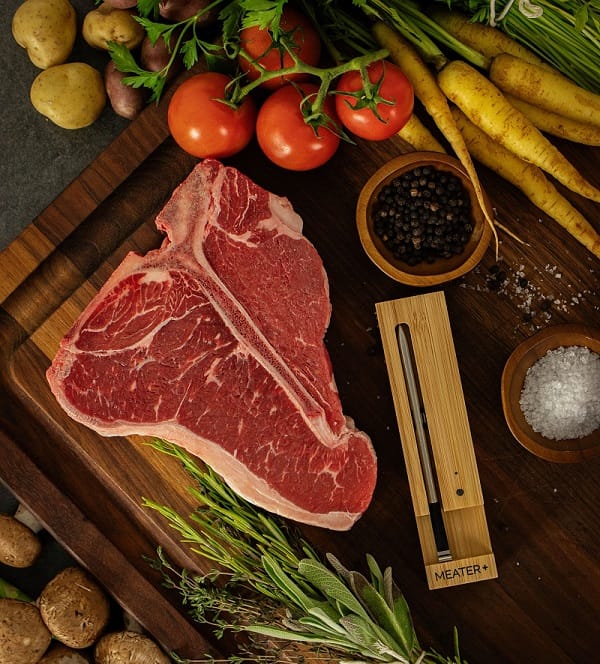
The T Bone steak is a classic cut widely recognized for its unique shape and exceptional flavor. It gets its name from the T-shaped bone that runs through the center, dividing the steak into two distinct portions – the tenderloin and the striploin.
The tenderloin, also known as the filet mignon, is the smaller portion of the T Bone on one side of the bone. This steak part is incredibly tender and prized for its melt-in-your-mouth texture. It is often considered the most tender cut of beef and is highly sought after by meat enthusiasts.
On the other side of the T Bone lies the striploin, which is larger and slightly less tender compared to the tenderloin. However, what it lacks in tenderness, it more than makes up for in flavor. The striploin is known for its rich, beefy taste and beautiful marbling, which adds juiciness and enhances the overall flavor profile of the steak.
When it comes to cooking a T Bone steak, it’s essential to keep in mind the different characteristics of the two portions. The tenderloin cooks faster than the striploin due to its tenderness, so paying attention to timing is crucial to ensure both sides are cooked to perfection. Some people prefer to cook the steak as a whole and then carve out the individual portions, while others choose to separate the tenderloin and striploin before cooking them separately.
No matter how you cook it, the T Bone steak is best enjoyed when cooked to a medium-rare or medium doneness. This allows the meat to retain its juiciness and tenderness while showcasing its incredible flavor.
Now that you know what T Bone is, you may be wondering how to select the perfect T Bone steak for your next culinary adventure. When choosing a T Bone, look for a steak with a vibrant red color, ample marbling, and a generous portion of the tenderloin and striploin. This will ensure a well-balanced and flavorful eating experience.
What Part of the Cow is the T Bone?
When it comes to the T-bone steak, it is important to know which part of the cow it comes from. This delicious cut of beef is taken from the short loin subprimal, found in the front portion of the larger loin primal. It is specifically cut from the muscle attached to the spinal vertebrae of the cow, between the rib cage and the pelvis.
The T-bone steak gets its name from the distinctive “T” shape of the bone nestled between two steaks, each of which is a prized cut of beef. One side of the bone contains the larger and meatier steak, the strip steak or sirloin, while the other contains the smaller and more tender piece, the tenderloin. These two steaks are highly regarded for their quality and are considered prime cuts for the dinner table.
How Does The T-Bone Steak Differ From Other Cuts Of Beef?
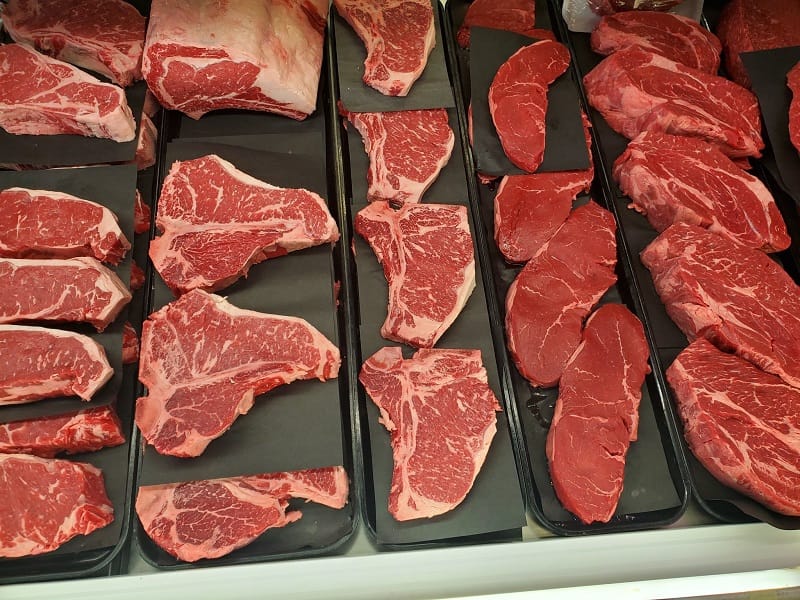
The T-Bone steak is unique because it contains two different types of meat in one cut. On one side of the T-shaped bone, you have the rich and flavorful strip steak; on the other, you have the tender and succulent filet mignon.
The bone in the T-Bone steak adds extra flavor and juiciness to the meat when cooked. It also acts as a natural conductor of heat, helping to cook the steak evenly.
The T-Bone steak is cut from the short loin section of the cow, which is located behind the rib and above the sirloin. This area of the cow typically produces some of the most tender and flavorful cuts of beef.
The size of the tenderloin portion in a T-Bone steak determines whether it is classified as a T-Bone or a Porterhouse steak. According to the Institutional Meat Purchase Specifications, the tenderloin in a Porterhouse steak must be at least 1.25 inches wide, while the T-Bone steak must be at least 0.5 inches wide.
T-Bone steaks are often considered a high-quality cut of beef and are highly valued by meat lovers. Combining the strip steak and filet mignon makes for a delicious and satisfying meal.
Are T-Bone and Porterhouse the Same Cut?
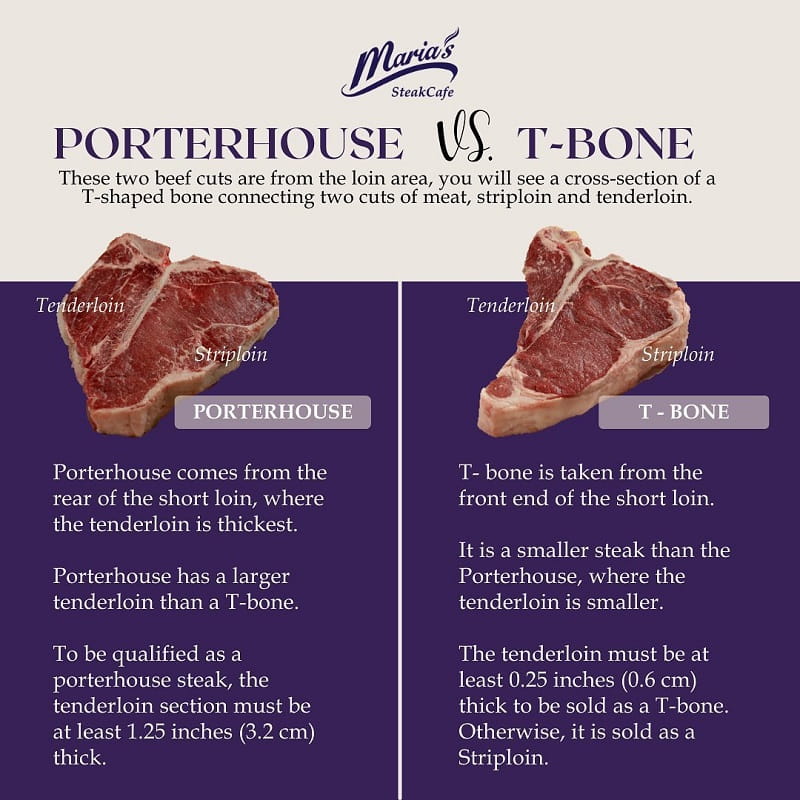
Both T-Bone and Porterhouse steaks come from the short loin of the cow. They both have T-shaped bones with meat on each side. However, Porterhouse steaks are cut from the rear end of the short loin and include more tenderloin steak along with a large strip steak on the other side of the bone.
The main difference between T-Bone and Porterhouse steaks lies in the size of the tenderloin. According to the U.S. Department of Agriculture’s Institutional Meat Purchase Specifications, the tenderloin of a Porterhouse must be at least 1.25 inches thick at its widest. At the same time, a T-Bone must be at least 0.5 inches thick. So, Porterhouse steaks have a larger tenderloin section compared to T-Bones.
It’s important to note that there is little agreement among experts on the tenderloin size needed to differentiate between T-Bone and Porterhouse. Therefore, even steaks with a larger tenderloin section are often called T-Bones in restaurants and steakhouses, even though they technically qualify as Porterhouse steaks.
To summarize, while T-Bone and Porterhouse steaks share similarities and come from the same part of the cow, the difference lies in the size of the tenderloin. Porterhouse steaks have a larger tenderloin section, making them a prized cut for steak lovers.
What Are The Characteristics And Flavor Profile Of The T-Bone Steak?
The characteristics of a T-bone steak are distinct and make it a standout choice for steak lovers. The bone, shaped like a T, adds depth of flavor and enhances the overall juiciness of the meat. The strip steak portion of the T-bone is renowned for its bold, beefy flavor and deliciously tender texture. On the other side of the bone, the filet mignon offers a more delicate buttery taste with a melt-in-your-mouth tenderness.
The flavor profile of a T-bone steak is a perfect balance of savory and succulent flavors. The marbling of fat throughout the meat adds richness and juiciness, resulting in an incredibly flavorful and moist steak. The strip steak portion is slightly more robust and offers a pronounced beefy taste, while the filet mignon side is more subtle and delicate.
To truly appreciate the flavors of a T-bone steak, it’s best cooked to medium-rare or medium doneness. This allows the marbled fat to render and infuse the meat with its incredible taste. Whether grilled, pan-seared, or broiled, the T-bone steak is a versatile cut that can be enjoyed in various ways, depending on personal preference.
What’s The Best Way to Grill a T-Bone Steak?
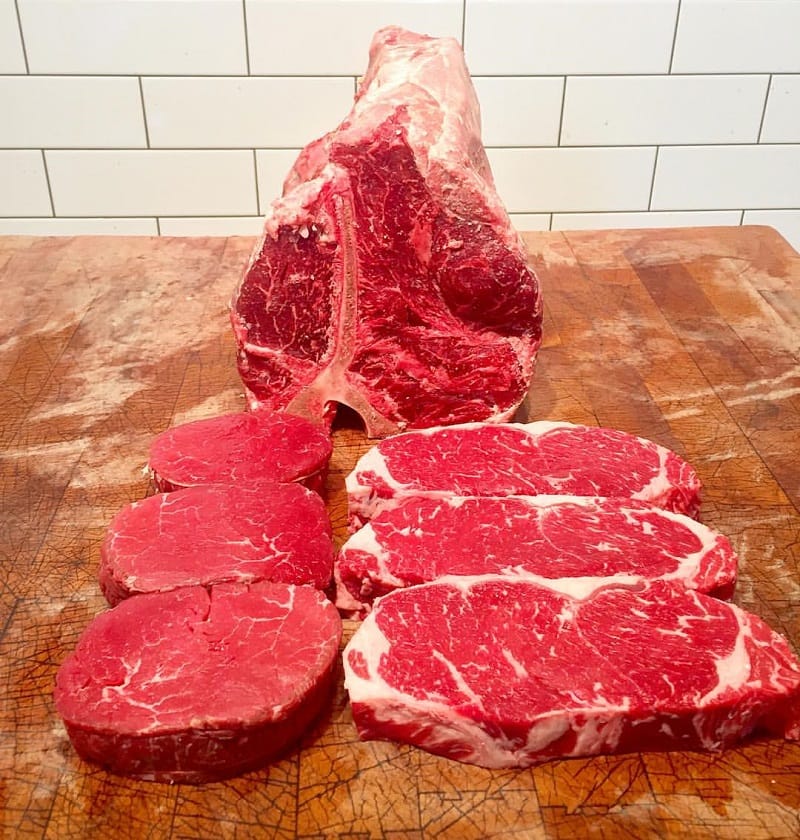
Grilling a T-bone steak can be a delicious and rewarding experience. After all, there’s nothing quite like the combination of tenderloin and strip steak all on one bone. But what’s the best way to achieve that perfectly cooked T-bone? Here are my tried and true methods that never disappoint:
- Start with a well-preheated grill: Preheat your grill on high heat so it’s nice and hot before you start cooking. This will ensure that you get a good sear on the outside of the steak while keeping the inside tender and juicy.
- Season generously: Before placing the steak on the grill, season it generously with salt and pepper. For added flavor, you can add other seasonings of your choice, like garlic powder or steak seasoning.
- Sear both sides: Place the T-bone steak on the grill and sear it for 3-4 minutes on each side. This will give you those beautiful grill marks and a nice crust on the outside.
- Use a two-zone grilling method: After searing, move the steak to the cooler side of the grill. This will allow for more gentle and even cooking, ensuring the steak cooks perfectly without burning.
- Monitor the internal temperature: To achieve the desired level of doneness, use a meat thermometer to check the steak’s internal temperature. For medium-rare, the temperature should be around 130 degrees Fahrenheit.
- Let it rest: Once the steak reaches your desired temperature, remove it from the grill and rest for a few minutes. This will allow the juices to redistribute throughout the meat, resulting in a tender and flavorful bite.
- Enjoy: Now; it’s time to savor the fruits of your labor. Cut into that perfectly cooked T-bone steak, and enjoy the combination of tenderloin and strip steak. For a complete meal, serve it with your favorite sides, like grilled vegetables or baked potatoes.
Remember, grilling a T-bone steak is all about balancing searing the outside and cooking the inside perfectly. With these tips and a little practice, you’ll be grilling T-bone steaks like a pro in no time. So fire up that grill, and get ready for a delicious meal!
Read more:
- Porterhouse Vs Ribeye
- Demystifying Butchery: What Is Eye Of Round Beef Cut?
- Filet Mignon Vs Sirloin
- Beef Tenderloin Vs Filet Mignon
Can The T-Bone Steak Be Used In Other Dishes Or Cuisines Aside From Grilling?
Yes, the T-bone steak can be used in other dishes and cuisines aside from just grilling. Its versatility allows for a wide range of cooking methods and flavor combinations. Here are a few examples:
- Pan-Seared T-Bone Steak: Searing the T-bone steak in a hot skillet adds a delicious crust and locks in the juices. I love seasoning it with salt, pepper, and garlic powder before searing it to perfection. This method is excellent if you prefer a medium-rare or medium doneness.
- T-Bone Steak Stir-Fry: Thinly slicing the cooked T-bone steak and using it in a stir-fry is another fantastic option. You can pair it with colorful vegetables like bell peppers, broccoli, and snap peas and toss it in a flavorful sauce like soy sauce and sesame oil.
- T-Bone Steak Tacos: Shred the cooked T-bone steak and use it as a filling for tacos. Top it with your favorite toppings like salsa, guacamole, and cheese for a delicious and satisfying meal.
- T-Bone Steak Salad: Slice the cooked T-bone steak thinly and use it as a protein-packed topping for a refreshing salad. Mix it with fresh greens, cherry tomatoes, cucumbers, and your choice of dressing for a light and nutritious meal.
- T-Bone Steak Sandwich: Slice the cooked T-bone steak and layer it on a crusty baguette or sandwich roll. Add caramelized onions, sautéed mushrooms, and a horseradish mayo spread for a mouthwatering steak sandwich.
Remember to experiment with new flavors and ingredients to create unique dishes using T-bone steak. The possibilities are endless, so don’t be afraid to get creative in the kitchen!
Health Benefits Of Nutritional Factors Associated With Consuming T-Bone Steak
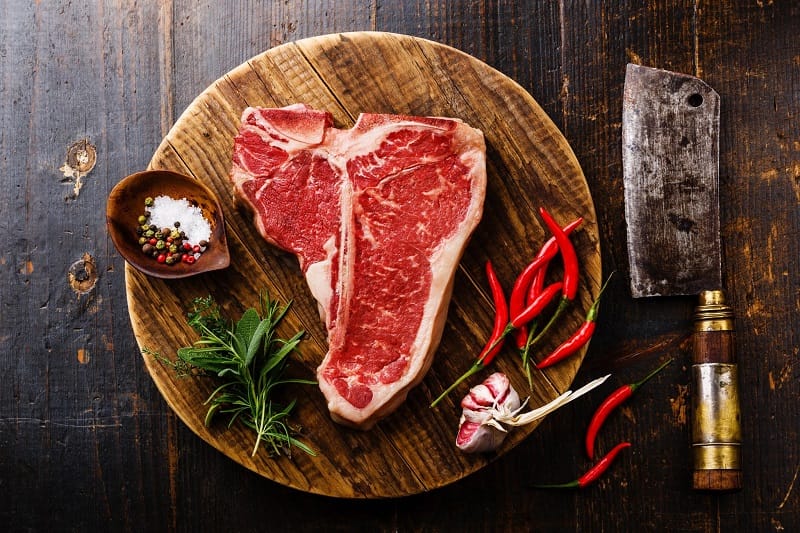
Let me share the nutritional factors associated with consuming T-bone steak that can contribute to a healthier lifestyle.
- Rich in Protein: T-bone steak is packed with high-quality proteins essential for maintaining healthy skin, hair, and nails. It also helps in building muscle mass and repairing tissues in the body. With about 27.3 grams of protein per 3-ounce serving, it’s a great way to meet your daily protein requirements.
- Good Source of Iron: Iron is a vital nutrient crucial in delivering oxygen to our cells and maintaining healthy cellular function. T-bone steak contains significant iron, with a single slice providing about 18% of your daily iron needs. This makes it an excellent choice for preventing iron deficiency and maintaining optimal health.
- Nutrient-Dense: Besides protein and iron, T-bone steak is rich in other important micronutrients like zinc, selenium, and B vitamins. These nutrients are essential for various bodily functions, including brain and muscle. T-bone steak is also a good source of carnosine and creatine, aiding muscle and brain function.
- Supports Dental Health: Surprisingly, T-bone steak can also contribute to maintaining oral health. Phosphorus in steak helps protect tooth enamel and promote overall dental health. So, the next time you have a steak, know you’re giving your smile an extra boost.
- Boosts Immune System: T-bone steak contains substantial amounts of zinc, a vital nutrient in strengthening the immune system. Zinc also helps promote brain health and supports muscle growth. Getting enough zinc in your diet prevents infections and inflammatory diseases.
- Aids in Weight Management: Contrary to popular belief, T-bone steak can be a part of a weight-loss diet! The high protein content in steak helps you feel fuller for longer, and the low-carb content makes it suitable for those following a low-carb diet. Just remember to practice portion control and opt for lean cuts of steak to maximize its weight loss benefits.
Incorporating T-bone steak into your diet can bring along these amazing health benefits. However, it’s important to enjoy it in moderation since it is also high in cholesterol and saturated fats. So, savor that delicious T-bone steak occasionally and reap the nutritional rewards it has to offer!
Tips For Selecting And Purchasing High-Quality T-Bone Steak?
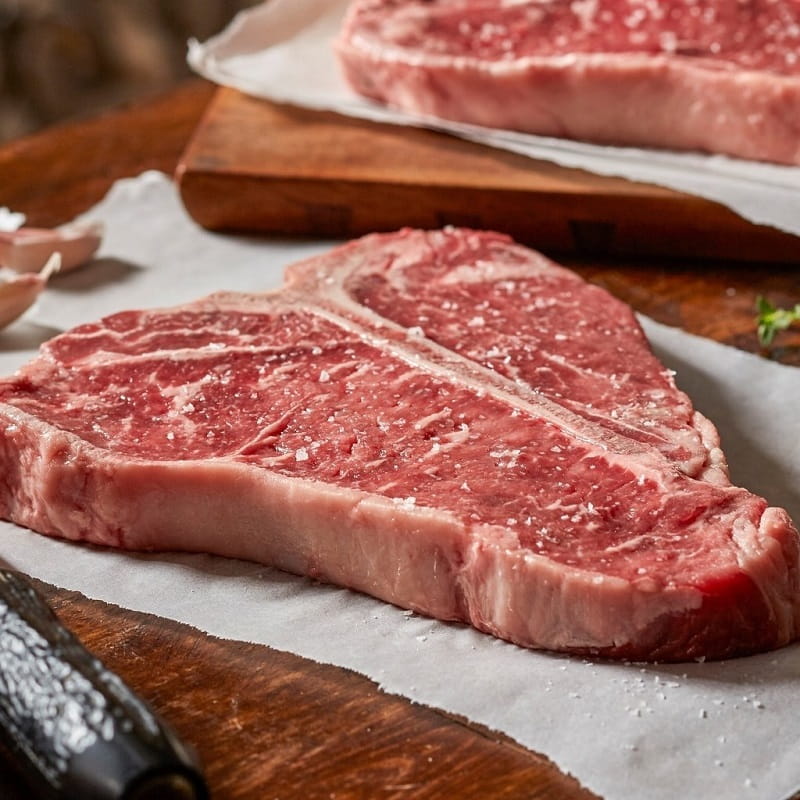
As a steak lover, I have learned a few tips and tricks on selecting and purchasing the best T-bone steak. Here are some tips that I would like to share with you:
- Check the Marbling: Marbling is the little flecks of fat within the meat that adds flavor and tenderness. Look for steaks with visible marbling, as they will have a richer taste. The more marbling, the better the quality of the steak.
- Consider the Source: The source of the steak is important in determining its quality. Look for grass-fed beef, which tends to have a fuller flavor and higher nutritional value. Grass-fed cattle feed on legumes, wildflowers, and wild grass, enhancing the meat’s taste.
- Thickness Matters: Opt for T-bone steaks with a thickness of 1 ¼ to 1 ½ inches. This thickness ensures the steak remains juicy and flavorful when cooked perfectly. Thinner steaks tend to dry out, while thicker ones may not cook evenly.
- Dry-Aged vs. Wet-Aged: Dry-aged beef is known for its intense flavor and tenderness. It is aged in a cooler with controlled humidity, allowing the flavor to concentrate and tenderize. Look for specialty food stores or butcher shops that offer dry-aged T-bone steaks for a unique dining experience.
- Trust Your Butcher: For the best T-bone steak, it is advisable to visit a specialty meat store or butcher shop where the butcher can cut the steak according to your preference. They can also provide guidance on the best cuts and cooking methods based on your taste and preferences.
- Consider the Price: High-quality T-bone steaks may have a higher price tag, but their flavor and tenderness are worth it. Remember, you get what you pay for when it comes to steak, so invest in a superior quality steak for a truly enjoyable dining experience.
FAQs About What Part of the Cow Is the T Bone
Can You Cook a T-Bone on the Stovetop?
Yes, you can cook a T-Bone steak on the stovetop! Enjoying a delicious steak dinner without firing the grill is quick and easy. Cooking times may vary depending on the thickness of your steak and your desired level of doneness. Use a meat thermometer to ensure accurate cooking. All you need is a hot skillet, some seasoning, and a few minutes of your time.
Here’s how you can do it:
- Preheat the skillet: Heat a large skillet over high heat until it’s smoking hot. This will ensure that the steak gets a nice sear.
- Season the steak: Season your T-Bone steak generously with salt and pepper or your favorite steak seasoning. Rub the seasoning into the meat for maximum flavor.
- Sear the steak: Place the seasoned steak in the hot skillet and let it cook for about 4 minutes without moving it. This will give it a beautiful brown crust.
- Flip and cook: Flip the steak over and cook for another 4 minutes on the other side. If you prefer your steak more well-done, you can cook it for a few minutes longer.
- Check for doneness: Insert a meat thermometer into the thickest part of the steak to check for doneness. For medium-rare, the temperature should be around 135°F (57°C).
- Let it rest: Transfer the cooked steak to a cutting board and rest for a few minutes before slicing. This allows the juices to redistribute, resulting in a tender and juicy steak.
How Does The T-Bone Steak Compare To Other Popular Cuts Of Beef Like Ribeye Or Sirloin?
First, let’s talk about the T-bone steak. It gets its name from the T-shaped bone that separates two delicious cuts of meat – the tenderloin and the New York strip. The tenderloin is known for its tenderness, and the New York strip is deliciously beefy.
Now, let’s compare it to the ribeye steak. The ribeye is sourced from beef rib and is known for its rich flavor and marbling. It has a higher fat content compared to the T-bone, which adds to its juiciness and tenderness. The ribeye is also often thicker than the T-bone, allowing for a better crust when grilled. It’s a go-to choice for many steak enthusiasts.
Lastly, let’s look at the sirloin steak. The sirloin is a leaner cut of meat compared to the T-bone and ribeye. It’s known for its beefy flavor and versatility. While it may not be as tender as the other cuts, it can still be delicious when cooked properly.
Conclusion
In conclusion, knowing what part of the cow the T-bone comes from helps us understand the characteristics and qualities of this popular cut. So, the next time you’re at a steakhouse or planning a barbecue, remember that the T-bone steak comes from the short loin section of the cow, offering a delightful combination of tenderloin and strip steak. Enjoy this mouthwatering cut and savor the flavors it has to offer.
References:
- https://www.foodnetwork.com/recipes/food-network-kitchen/pan-seared-t-bone-steak-recipe-2103356
- https://en.wikipedia.org/wiki/T-bone_steak

Hello! I’m Wyman Brooks, the owner of Tired Texan HairStyle and Beauty. My journey in the beauty industry began with a simple passion for hair and aesthetics, and over the years, I’ve turned that passion into a thriving business.
At Tired Texan, we pride ourselves on providing a welcoming and friendly environment where clients can feel relaxed and rejuvenated. We offer a wide range of services, from stylish cuts and vibrant color treatments to rejuvenating spa services. My team and I are dedicated to helping each client look and feel their best.
